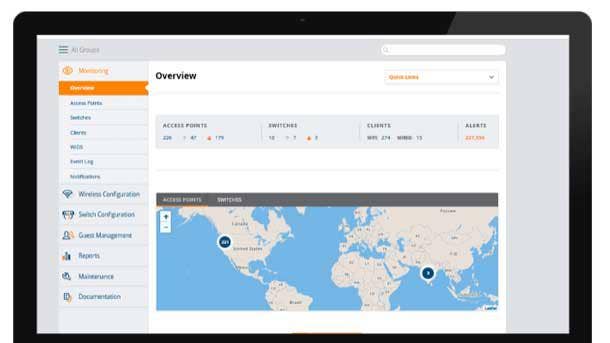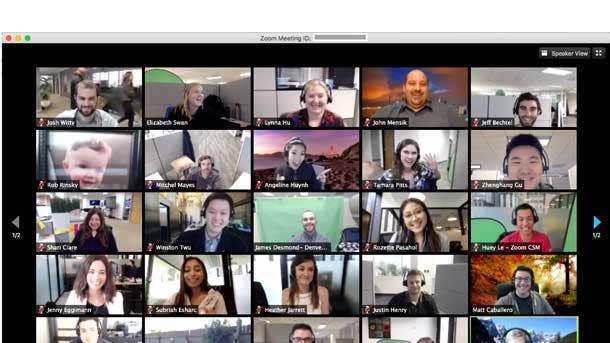Aruba Networks' Keerti Melkote On COVID-19 ‘Accelerating’ Network Transformation Connectivity In Crisis
Aruba founder Keerti Melkote shares how the networking firm’s employees, partners and customers are setting up new networks on the front lines of the coronavirus pandemic, how Wi-Fi and 5G will work together to empower the next decade of innovation, and how any doubt around the importance of digital transformation has been “completely removed.”

Productivity is powered by secure, high-quality connectivity. And connectivity is needed perhaps now more than ever as the COVID-19 coronavirus pandemic brings sweeping changes to employees, students, and the healthcare industry around the globe.
That's where Aruba Networks came in. The 18-year-old networking specialist has been focused on “the edge of the network” in recent years, and that focus couldn’t be more relevant today as millions work and learn from home. Keerti Melkote, co-founder and president of Aruba Networks, said there’s been a “crazy surge” in demand for remote management solutions – particularly, for a remote access point product that Aruba developed during the H5N1 outbreak -- as companies embrace work-from-home scenarios more wholeheartedly. And now is the time for partners to shine with edge-as-a-service and managed solutions to help them empower their customers in a “no-touch” manner for the time being, he said.
Melkote talked to CRN about how the pandemic has changed how Aruba develops products, the digital transformation that COVID-19 has forced and the future of Wi-Fi and 5G, and how the networking company’s customers, partners, and employees are helping on the front lines in the U.S. and overseas by bringing connectivity to places its never been before, including hospital parking lots.
Here are excerpts from the conversation.

How is Aruba Networks helping on the front lines of the COVID-19 pandemic?
We started to see an emerging need for creating increased capacity in healthcare facilities, be it for patients coming in for COVID-19 treatment or patients getting treated for other medical reasons. There was an increased need for triage for patients that were coming in with symptoms that didn't quite know whether they had COVID-19 or not, and there was a move toward setting up triage tents outside of hospitals. Finally, there were a bunch of testing stations that were beginning to see the need for in various locations for drive-through testing. All of this required infrastructure and connectivity is pretty core to doing anything in a hospital. Whether it's to admit someone, file a medical report, or prescribe drugs, everything is done online and requires access to medical applications and connectivity is at the heart of everything.
We started to see a bunch of requirements and requests from customers. What we decided to do was inspired by our Italian team -- one of our systems engineers, along with a partner, picked up a bunch of Aruba access points drove them to a floating cruise ship that was converted into a hospital and set up a wired and wireless network in the facility for doctors and nurses to access. That was all done in a matter of days. We got inspired and said; "Hey, why don't we take this and make it something we can make available to pretty much anybody who wants it?" So, we created first the idea of a Volunteer Corps. We have the Aruba Airheads community that meets physically every year and we have over 100,000 engineers strong across our customers, partners, and employees. We basically said, "For those of you that are interested in volunteering your skills and time to help set up these temporary healthcare facilities, we would give the equipment needed to go set this up." We contributed, in kind, about $50 million worth of these healthcare kits. This was very well received in the community -- we had over 500 volunteers last I checked and over 37 countries have taken advantage of the healthcare kits.
It's really heartening to see the community stepping up to help their own communities in times of need. In addition to that, we have seen interesting extensions. The San Antonio Spurs organization -- they're an Aruba customer -- along with AT&T, opened up their parking lot for anybody who wanted access to broadband connectivity, especially those in low-income neighborhoods that may not have the access they need. We are seeing some schools also open their parking lots so people can sit in their cars and take advantage of the connectivity that they have or need access to it at various points. To me, it's really been a complete transformation in the way the last few weeks have gone from our normal course of business to really reacting to this pandemic and how we can help the communities that we live in.

Is Aruba seeing new demand for different products today due to COVID-19?
While healthcare and taking care of our frontline healthcare workers was the first priority for us, the real crazy surge in demand that we have seen is for the work from home or learn from home-type of scenarios. Clearly, the need is there for accessing applications. In a school's case, it's classroom applications, curriculum content, as well as access to video conferencing and the ability to do distance learning. That has triggered a need to create a stable, secure and usable experience for employees that are working from home or for students that are learning from home.
We built a Remote Access Point (AP) solution back in 2008 to combat the [H5N1 Avian flu] that had just broke out. Some customers in the financial services industry took advantage of the remote AP and deployed it in executives' homes to ensure that they had business continuity even when there was an epidemic going on. This time around, of course, COVID-19 is far more disruptive than what SARS was to the world and we're seeing every corporation, every industry, and every school figure out the means by which they can connect their users, be it employees, students or teachers, or in healthcare, telemedicine for doctors and nurses. There's a huge rise in the work from home use case and a dramatic increase in demand. The value proposition we offer is the transparent, secure and easy way to connect into a network. The alternative, of course, is the VPN client that everybody is used to. When you go to a workplace, you don't use the VPN -- the network is secure. Your device just automatically connects and you're off using your applications. The VPN was certainly not built to be an always-on type of solution; it was built for occasional use. What this remote AP architecture allows customers to do is to have a more stable always-on type connection in people's homes and really deliver a great user experience. Now, obviously, demand has gone through the roof on that particular product and so we are reacting to that in our supply chain to provide customers with the products when they need it. That's the Aruba approach.

Are you seeing trends such as edge computing gaining momentum as a result of the pandemic as many work and learn from home?
Yes, but I think the big thing that is changing now is that it is not possible anymore to touch a device or a site that may need service. In the past, you could create a model by which an IT person could show up at a site and troubleshoot a problem or install a device -- you would have a skilled hand on the other side to take care of things. But in this current world, that is very, very difficult to do and not safe to do anymore. Remote deployments [and] remote management has become extremely important in this new era as people deploy edge solutions, be it edge computing or edge networking or storage. It is the ability to manage, monitor, troubleshoot, and even deploy things remotely. The idea of zero-touch everything is becoming very, very critical.
For us, thankfully, we've been in a pivot to a cloud-based architecture for all the Aruba solutions using Aruba Central. That is coming in very handy for customers to be able to stay at home, be safe, and yet have total visibility and access to their entire enterprise environment.

Could this trend cause problems for partners who are used to visiting their customer sites?
No, because I think for partners, this is effectively an opportunity to really increase their services component as opposed to just being box sellers -- box resellers are certainly relevant and important -- but I think there's an opportunity to offer value added services, which has been my exaltation to the partner community; to really go beyond the box and offer value added services on top because that provides a more sticky revenue stream. Becoming an MSP is certainly a better option.
The challenge [for partners] tends to be around becoming an MSP, which in the past, required a lot of investment on their side. With the cloud, they don't have to go invest in a [network operations center [NOC] and a set of servers and application software, etc. They can take advantage of Aruba Central, they can sign up as an MSP on it via white label and basically provide that as the remote management capability for their customers. We're trying to lower the barrier to what it means to become an MSP in the modern era. And certainly, in this COVID-19 era, it is a very, very important way in which they can stay connected to their customers and really offer that additional value.
I think this whole idea of edge as a service is going to be very important. And edge is a broad term. I think it includes networking, computing, and security. Increasingly, customers are asking for turnkey solutions for the edge so that they don't have to manage the different components themselves. So for partners, it's really an opportunity to offer the edge in an all-inclusive service with Wi-Fi being a starting point for many, but it can go way beyond that as well. I also think this remote AP, work from home opportunity is another great opportunity for partners to really now take advantage of their connectivity to their customers, to go in there offer their help, and help roll out these work from home solutions.

Post-COVID 19, what should solution providers focus on?
I think first and foremost, and this is what I'm telling my team as well, they have to look at their entire business and which businesses are likely to recover sooner than others. I think we can make some guesses -- travel, obviously, is going to be impacted for a little while, and that means hospitality will also be slower to recover -- whereas other industries, [such as] the government, etc., will do better. So, pivoting first to the areas that are going to do better than others I think is step one.
Those areas include healthcare, especially once they recover from the pandemic. I think there's a clear need to improve the infrastructure. I also think in the public sector for schools, K-12 and even higher education to some extent, will look at this as an opportunity to redo their infrastructures. I think critical infrastructure in general, having that ability to do remote monitoring and remote visibility in the case of future pandemics and preparing will be important. Business continuity is going to be the primary topic that most people are going to discuss.
The other piece that is going to be important along with business continuity is the ability to extend our [customer's] cash and operational capability. We have HPE Financial Services that can offer the ability to finance any equipment that they might need and extend their cash flow over a period of time as opposed to putting it all upfront. Partners can take advantage of that as well.
Customers are just reacting to the immediate need, but I believe that as this work from home [trend] is becoming the new norm, and they're taking a more proactive stance now that the reacting is done and people are able to connect from home on making the experience more pleasant and productive so they can gain benefits from it. I think that is the next phase. And I think that's really where partners can help their customers. Go talk to your customers. Overall, I think people will … say, "How can I use this as a way to reduce my total cost of ownership in my infrastructure while preparing for the future at the same time?"

What is the impact that videoconferencing is having on Aruba's networks right now?
[Everything is] happening from home, so the first impact is to the broadband lines that we have at homes and to the core of the Internet and the backbone. The reality is, things have held up -- the applications have held up. Zoom and WebEx and others have held up quite fine as well, which really speaks to the resilience of the internet and the capabilities we have built.
In the home network, however, what we are seeing is that one access point sometimes isn't sufficient. It might be sufficient to cover your "workspace," but when you have your entire family at home and potentially multiple videoconferencing sessions going on at the same time, you can't all be huddled in the same room and doing it. In my own case, I can tell you my kids are in their rooms taking in their Zoom classes, and my wife and family are doing Zoom in other places in the house, so the need for good Wi-Fi coverage inside the house has gone up quite a bit as opposed to just providing that single access point that your internet modem or broadband connection might give you. In Aruba's case, our differentiation is security. Providing that secure work from anywhere inside the home has increased in value.

How is Wi-Fi and 5G going to work together in the future to enable new use cases, post-COVID-19?
Wi-Fi is going to places where I did not expect it to, to be totally honest with you. All the use cases I’ve described in healthcare right now, which is all outdoor use cases, is something that a cellular network could serve. Also, retailers are setting up curbside delivery right now, and that's translating into outdoor deployment of Wi-Fi for us because these businesses need to serve customers not inside the store, necessarily, but deliver their goods outside the store, which means access to business critical applications on the curbside. I think that that is changing the dynamic for Wi-Fi in the short term for sure.
In the long run, I continue to see Wi-Fi being that small cell technology that will serve primarily high-density, secure use cases, and 5G as more of the overlay canopy for when you're in the car driving between point A and point B to remain connected. I think just like Wi-Fi and cellular have played well together over the years, I see the same dynamic playing out with Wi-Fi 6 and 5G. The excitement, though, is really about new use cases above and beyond the mobility use cases that we are all used to on our phones. For example is, in 5G, we are talking about helping with autonomous driving vehicles and so on, and that's a fantastic use case for 5G. But now you go inside a warehouse and there are these new devices called autonomous guided vehicles -- they're basically robots on wheels that move inventory around in a warehouse -- and 5G doesn't really serve or cover indoors quite well. Wi-Fi 6 is a perfect complement to 5G to enable that kind of use case to happen. My view is that Wi-Fi 6 and 5G will drive a whole new range of use cases beyond what we are all used to, and that is where the next decade of innovation is going to be, in my opinion.
The FCC is licensing the 6GHz spectrum for use with Wi-Fi and that's another fantastic initiative to really allow for all these fancy new use cases to really come to life. I have a fairly unique perspective here because when I started Aruba back in 2002, the 5GHz spectrum, which we all take for granted today in Wi-Fi, was barely even in existence. It was all about the 2.4GHz spectrum. Today, 18 years later, 95 percent of devices on the Aruba networks out there are connected over 5GHz. I could not have told you that that would be the case back in 2002. There was still a lot of concern and speculation on whether 5GHz would be even successful. I see the same thing with 6GHz and I think it's going to drive the next set of use cases on augmented reality and virtual reality gaming, certainly on the consumer side, and in a lot of the robotics and automation use cases on the enterprise side.

Has the pandemic changed the way Aruba is developing products and services?
Yeah, absolutely. We have definitely prioritized two big things. One is managing everything that we offer from the cloud using Aruba Central. The second is the remote AP use case how we allow for remote work to happen more securely and more fully. Those aspects of the roadmap have increased in priority in the recent past in reaction to the pandemic. But the rest of the roadmap still is very much intact. We just released our new CX line of switches to create that integrated offer from the wiring closet to the data center, and that is doing well -- it's a new product line that we launched and I'm very pleased with the momentum that I'm seeing there. And of course, there is SD-WAN. This is an important capability because as cloud becomes more important and the edge becomes more distributed, the connectivity between the edge and the cloud will be in SD-WAN. We've integrated that into the architecture to deliver that edge to cloud experience for customers. SD-WAN originally was meant for branch offices -- we call it SD-Branch. But now, it has become the SD-Home. We have gone from a few campuses to potentially hundreds of branches, to now thousands or tens of thousands of homes that need secure connectivity. The footprint of the SD-WAN is dramatically increased, so we have to now figure out how we cost-effectively provide solutions that scale up to tens of thousands or hundreds of thousands of homes.

How do you see the future of the workplace or school campus changing as a result of the pandemic?
It's a good question. I think, certainly, we have proven that we are going to be as productive, if not more productive, working from home as a population. I think there'll be more proactive measures taken by corporations to support work from home more wholeheartedly, and I think there will be infrastructure investments to enable that to happen. A certain percent of the population with a workforce that can work from home will probably make a permanent adjustment to working from home.
Fundamentally, I think the transformation that is going on will be accelerated. The post-pandemic response is going to be the emergence of the edge as an important area of work for our partners. To me, the edge is all about data -- new types of data that is being created at the edge and how we process that data. AI and AI technologies are going to be extremely important to address this emerging rise of the edge. We will talk a lot more about how AI and AI operations in general are going to help customers with automating what they are going to do at the edge and provide insights into their business-critical systems. I think it is very clear that digital transformation is going to accelerate because of this pandemic. If you ever had a doubt that digital is not foundational to your business, that doubt has been completely removed by how we've all basically come around to using digital platforms to continue our work and be productive.